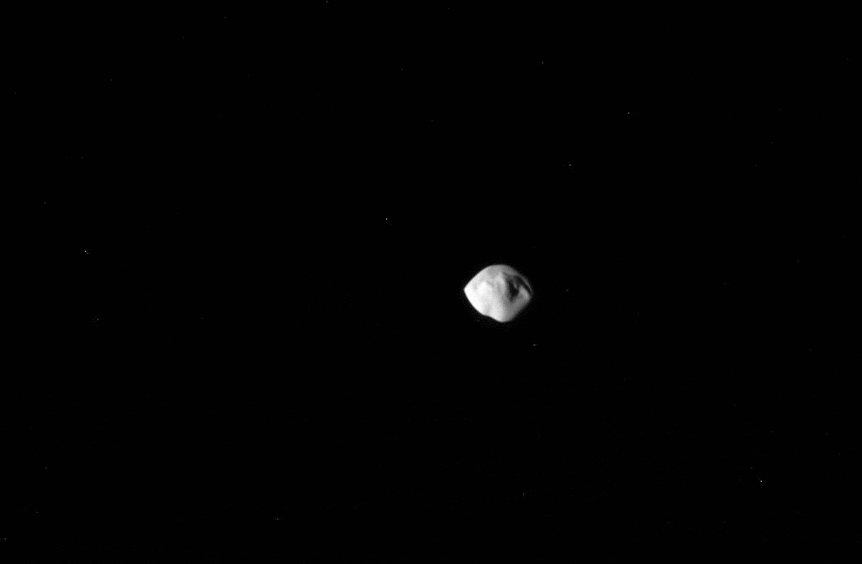Create a free profile to get unlimited access to exclusive videos, sweepstakes, and more!
Another flying saucer invades Saturn. Or ravioli.

The Cassini spacecraft has entered the final months of its more-than-a-decade-long mission to explore Saturn, its rings, and its truly weird moons. Some months ago it started a risky but high-reward phase: going on polar orbits, passing over Saturn’s north pole and diving down to just outside the main rings.
When it does this, it can pass pretty close to some of the smaller moons. These moons are small enough that gravity only partially shapes them, and other forces at work can sculpt them into bizarre designs.
The image above shows Atlas, a perfect example of this. It’s a flying saucer! Or a raviolo*. Take your pick. On April 12, 2017, Cassini passed just 11,000 kilometers from the 40-km-wide Atlas, taking a series of pictures that shows just how strange this little moon is.
I know, right? The equatorial ridge is really amazing, but it’s not unprecedented. Cassini saw the same thing when it got close to the moon Pan in March 2017; that, too, has a ridge of material rising up around its equator. The origins of these ridges on Pan and Atlas are probably very similar: The buildup of ring material falling down on the moons’ equators.
So, why does the material pile up along the equator, and not all over the two moons? It’s because of where the moons are, and the shape of the rings.
Pan orbits Saturn inside a gap in the A Ring, the brightest of Saturn’s main rings, at a distance of about 133,600 kilometers from Saturn’s center. Atlas orbits just outside the A Ring, at a distance of 137,700 km from Saturn’s center. Both orbit Saturn in about 14 hours.
Because they’re so close, the gravity of each moon, weak as it is - you could easily jump off either of them and never fall back - pulls in ring particles. The rings, themselves, are incredibly thin, just a dozen meters thick in general (to scale with their diameters of hundreds of thousands of kilometers, Saturn’s rings are thinner to scale than a sheet of paper). The moons orbit almost exactly in the plane of the rings, so the icy particles making up the rings fall right along the moons’ equators.
Well, mostly, they do. Pan shows evidence of what looks very much like slumping material, as if the stuff piling up at higher latitudes has cracked and fallen, like an avalanche. Atlas also has those, though they look softer, fuzzier. I wonder if they may be due to the small centrifugal force created as the moons spin; they rotate once per orbit, so once every 14 hours. That creates a slight outward force at the equator, which would feel like a downhill slant to a particle at higher latitudes.
The ridge on Atlas is much higher than on Pan. This may be due to their different orbits. Although both orbits are very nearly circular, they are actually slightly elliptical, with Atlas’s orbit being more so than that of Pan. That means that ring particles hit them in different ways; they fall on Pan more gently than they do Atlas. Think of it this way: Pan’s more circular orbit means it’s on a very similar orbit as any ring particle it passes, so it moves past them very slowly, relatively speaking. But the orbit of Atlas deviates from a circle more, so, sometimes, it’s moving faster than nearby ring particles (when it’s closer to Saturn in its orbit) and sometimes more slowly (when it’s at the farthest part of its orbit from the planet). The physics of this is a bit complicated, but this means that, for Pan, the particles pile up more on the sides of the moon facing toward and away from Saturn, while on Atlas they pile up more on the leading and trailing hemispheres (the half of the moon facing into and away from its direction of motion around Saturn). Also, remember, Pan is in the rings, while Atlas is outside them. All of this may account for the differences in the ridges.
But honestly, it’s not clear. There may be other mechanisms at work here.
The beauty of this is that we’d never know any of this without Cassini - specifically, without Cassini being at Saturn so long. The Voyager probes flew past Saturn at high speed, and didn’t have much time to gawk. Cassini has been orbiting Saturn for a more than dozen years, so it’s been able to see more.
It’s also been able to see changes, which is critical. We’ve been able to monitor Saturn over nearly half its 29-year orbit, which means seeing things evolve as seasons change (it was just after northern winter solstice when Cassini arrived, and now we’re close to the northern summer solstice). The atmosphere of Saturn has changed, the angle of sunlight illuminating the rings has changed, and perhaps the moons themselves have changed subtly as well.
It would be nice to have a mission stay at Saturn for a whole Saturnian year. Or two. Or twenty. But we aren’t there, yet, and the clock for Cassini is running out. We have a few precious months left of this fantastic mission before it ends. What more wonderful things will it show us?
* Yes, the singular of ravioli is raviolo. However, I prefer to say raviolus, because it sounds vaguely biological.




























